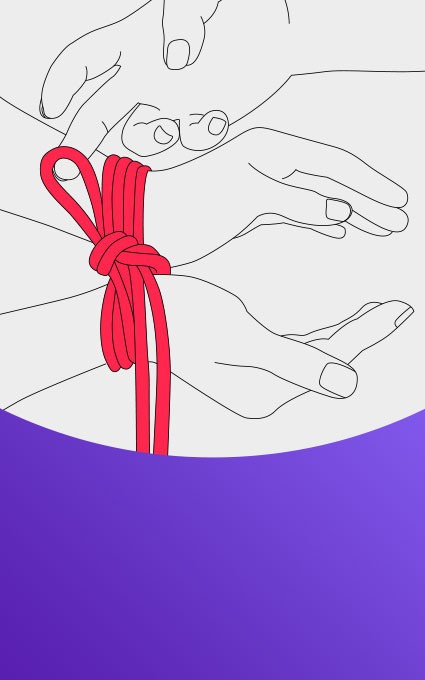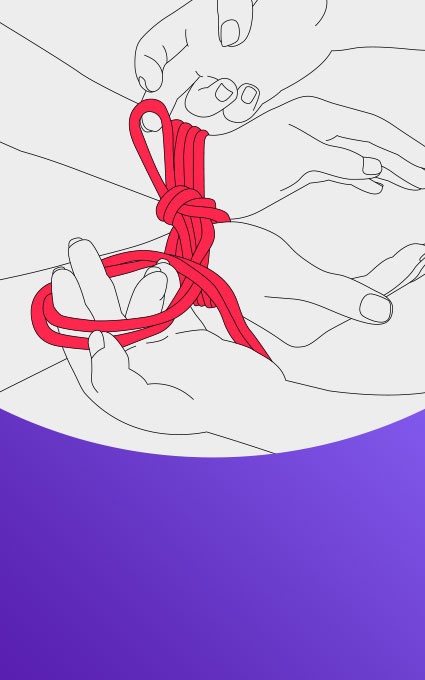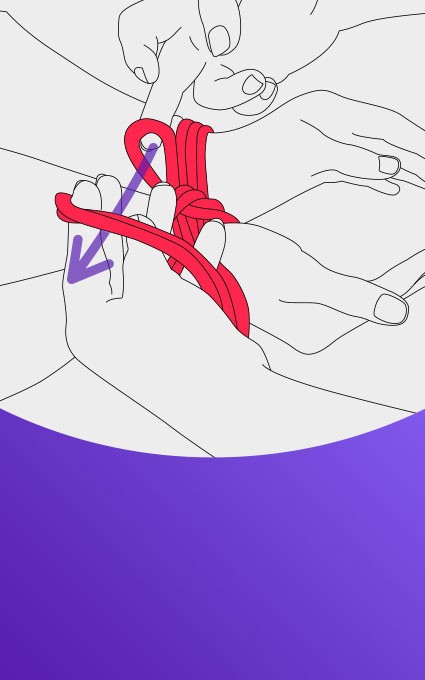Bring elegance and beauty to BDSM with Japanese rope bondage. This ancient art form is all about restraining and displaying the body, the pleasure of binding your lover, and of being bound.
While this style of bondage began in Japan centuries ago, it’s now something BDSM fans enjoy all around the world. Studies show that about one third of couples include elements of bondage play in their sex life — and also that kinky play can enhance relationships and boost emotional intimacy (when both partners are equally into it, of course).
Ready to try this intimate, sensual art for yourself? We’ve got Japanese bondage for beginners all wrapped up!
Only got time for a quickie?
Here are the headlines on erotic bondage. If you’ve got time for more detail, jump ahead to the full article.
- Japanese rope bondage is the sensual, artistic practice of using rope to bind your lover.
- Before you play, make sure you learn how to protect each other during a session to keep things playful and avoid injuries.
- Get into character as a sub or Dom; chat with your partner about which role they’re drawn to, too.
- You can watch tutorials or attend a local class to find out how to tie safe bondage knots – as well as learning all about the BDSM community.
- To combine sex and shibari, choose a bondage sex position where the sub can comfortably receive pleasure – such as spooning.
- Physical and emotional aftercare is essential, and offers another way to bond and build trust between you and your partner.
Japanese bondage is the seductive art of binding a lover as part of erotic play, using specialist knots to safely restrain them. As well as being something people enjoy playing out together in private, there are also performance artists and kink-themed bars that showcase Japanese rope tying. You can find it in porn, too.
There are two Japanese words you might hear that are used to refer to this bondage practice: shibari and kinbaki. They’re often used interchangeably but mean slightly different things.
While shibari means ‘tying’ or ‘binding’, kinbaku means ‘tight binding’, and implies that the bound person won’t be able to move. But there’s more. Shibari is the tradition of tying knots in an artful, precise way – whereas kinbaku is specifically an erotic practice of using rope to restrain somebody, with aesthetic, emotional, and sensual significance.
Bound for pleasure
Japanese rope bondage may be type of kink for some, but it has its roots in hojojutsu: a martial art that involved restraining enemies and criminals using rope. Which makes sense of why it’s found its way into Dom/sub play: it’s a way to display and explore power dynamics.
A psychological study into shibari describes it as, “the art of tying knot patterns on the human body, to restrain and give sensation in multiple layers of physical and emotional stimuli”. There's a lot of trust and vulnerability involved in binding and being bound, which can help to deepen intimacy between you and your lover.
The intensity and somatic pleasure of being bound is unique to this style of bondage, which is part of what makes it so intriguing. And if you’re wondering, ‘somatic’ means ‘relating to the body’; it’s all about the sensations we experience physically, like vibrations and temperature change. The touch of hands or rope, as well as the awareness of your body’s position, can feel incredibly sensual and arousing to some people.
A key part of building that trust is to focus on each other’s safety – before, during and after the session. Here’s how:
- Never assume someone knows what they’re doing, or that they’re safe. Take time to talk before you start, agreeing on any boundaries and keep an eye out for any red flags.
- Before you start, feel the receiver’s (or ‘bottom’s’) hands to check their baseline colour and temperature. That way, you’ll notice if they change colour or get cold later. If you spot this, loosen the knots and check in with them.
- It’s important to play when you’re both sober, calm and relaxed. Check in with the receiver to make sure they’re not feeling anxious or claustrophobic.
- Agree on a safe word or action, and make sure the bottom is comfortable letting you know about any numbness, tingling or burning in their limbs, hands or fingers.
- Never leave your bottom alone for more than a few minutes.
- Tie over larger muscle groups like upper arms, thighs, chest and hips. Avoid areas like armpits, back of knees, inner wrists or inner thighs.
- If the bottom starts to panic, help them to relax by asking them to count backwards from 100 and breathing slowly from their belly (not their chest). As they do this, untie their ropes quickly and calmly – or use safety scissors if you need to.
Once you’re ready to start exploring bondage play, here’s how to master the basics. Soon you’ll be ready to get stuck into your first “scene” (that’s the term the community uses for a BDSM session).
Get some guidance
Find your people: look online for a local fetish club or shibari class so you can learn how to practice bondage safely from those already in the BDSM community. Picking up skills in person, rather than through online tutorials, means you’re able to ask questions and have someone experienced guide you through the ropework essentials.
This should help to give you confidence with the safety side of play, as well as giving you a chance to discuss anything you’re unsure of: what’s involved in the Dom and sub roles, how to get into character if you’re new to BDSM play, key knots to learn, the best bondage rope to use…
Discuss your roles
Typically, there are two roles to play in Japanese rope bondage:
The person tying the rope: known as the rigger, caster, rope top, or nawashi
The person being tied: known as the rope model, rope bottom, or receiver
If you’re unsure what role’s for you:
The rope top might be someone who enjoys roleplaying as an aggressor, captor or Dom. They could also enjoy the process of carefully tying up their partner, making sure they’re safe and secure in their role as a sub.
The rope bottom might be a good fit for someone who likes getting into character as a captive or sub, and giving up control to their lover. They could also take pleasure in the feeling of rope being wrapped tightly around their body – or could be into directing the tying themselves, taking on a Dom role.
Discuss the options with your partner: it might be that you each fit naturally into a role, or that you’d like to take it in turns. Exploring is all part of the experience; building trust and deepening your connection with your lover.
Choose a position
Pick poses that reveal the areas you’d like to pleasure, so that you’ll be able to dive right in once your partner is bound. Remember: before you start a scene, make sure you’re both clear on your boundaries. Go in knowing exactly what you’re both excited to try, and what you want to avoid, during the session.

The Peach
The rope bottom kneels down, knees about a shoulder width apart. Next, they lean forward to rest their forearms on the floor in front of them, putting their anus and genitals on display.
Use rope to secure them in this position, tying their upper arms to their thighs. Then, as the rope top, you’re free to kiss, lick, tease and penetrate.

Shibari Spoon
The rope top binds the bottom’s legs, so one ankle is secured on top of the opposite thigh. Next, bind the bottom’s wrists and tie their top arm to the top thigh.
This will hold them in the ideal position for spooning-style sex.
Know your rope
Getting the right kit is key. With specialist bondage rope, you avoid issues like chafing because it's made of fibres like cotton or nylon; these materials offer a soft yet satisfyingly sturdy feel.
Traditionally, Japanese bondage is practiced with seven-metre ropes – but anything between five and ten metres will give you enough length to work with. We recommend starting with ropes on the shorter side, because they’re easier to manage as a newbie.
Start simple
It’s easy to go down the rabbit hole online and find all kinds of stunning (but advanced!) ropework designs. There are some incredible rope artists out there who are very experienced casters, as well as rope models with assistants to help them get everything looking perfect.
As someone trying rope bondage for the first time though, it’s best to start with a beginner knot – like a column tie. And avoid knots that tighten as you pull, because these could quickly become dangerous.
Single column tie
The ‘column’ refers to the thing you’re tying: an arm, leg, chair arm or bed post. As an example, we’ll use a wrist:
- Fold the rope to form a "bight"
- Wrap the bight around the wrists twice
- Keep two fingers between the rope and skin
- Bring the bight between the wrists, wrapping around the rope cuff
- Tie a simple shoelace knot using the bight and the long ends of the rope
- Twist the long ends of the rope to form a loop
- Bring the bight through the new loop
- Pull the long ends of the rope to tighten the knot, making sure the rope isn't twisted
Check in
If you’re the rope bottom, check in with yourself throughout the scene: if you start to panic, or your limbs are tingling or going numb, let your top know right away. As the top, ask your bottom to rotate their wrists and hands every now and then, just to see how they’re feeling.
If the rope bottom is gagged, squeeze their hand and ask them to squeeze back to let you know they’re doing okay. If they need a break or aren’t feeling quite right, quickly and calmly untie them. Let them know you’re there to support them, and that it’s not a problem at all to break the scene.
Make time for aftercare
If the rope bottom has any soreness, help to soothe these aches with a gentle massage or by applying moisturiser. Take the emotional and mental side into account, too; being tied up can bring a sense of vulnerability or anxiety to the surface.
It’s important to give each other space to share how you’re feeling, to reconnect and reaffirm trust after the intensity of the scene. Setting aside time to show respect and care for each other in this moment will help to deepen your bond even more.
Stock up on your BDSM essentials: Shop bondage gear























